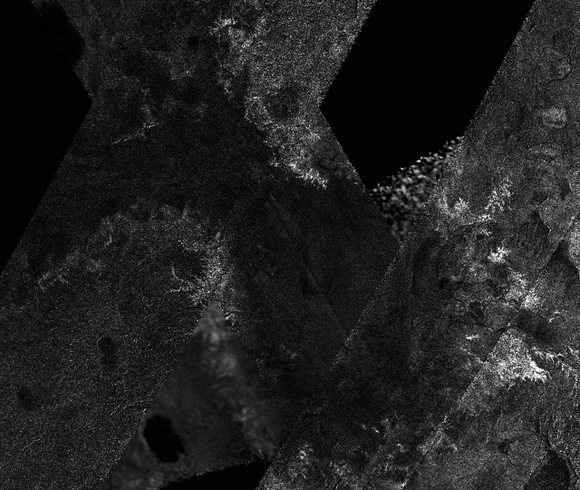A lecture as part of the World Astronomical Union conference taking place these days in Rio de Janeiro shows how much the similarity is on the difference between the two worlds so far away

Titan is over a billion miles away, but as astronomers learn more about it, it looks more and more like Earth.
This week the topic of Titan came up for discussion in several lectures as part of the meeting of the World Astronomical Union in Rio de Janeiro (as I recall at a similar gathering in Prague in 2006 the question of Pluto's membership in the kingdom of the planets came up for a vote and he lost, this time the conference seems to be more concerned with science). Two NASA researchers, Rosalie Lopez and Robert Nelson of the Jet Propulsion Laboratory (JPL) in Pasadena, California, report that weather and geology worked in a similar way on Earth and Titan, despite the fact that Titan is 100 degrees Celsius colder than Antarctica.
The researchers also reported that tantalizing hints of life have been discovered: Titan maintains a chemistry similar to the conditions that existed before life existed on Earth.
Wind, rain, volcanoes, plate tectonics and other processes similar to the Earth's sphere shaped the formations on Titan's complex and changing surface - except for those frozen volcanoes (cryovolcanoes) that emit a thin mixture of water ice and ammonia instead of the hot lava on Earth.
"It's really surprising how much Titan resembles Earth," says Lopez. "In fact, Titan looks more like Earth than any other body in the Solar System, despite the large differences in temperatures and other environmental conditions."
The Cassini-Huygens mission revealed details about Titan's young geology that showed very few impact craters, towering mountain ranges, dunes and even "lakes". The radar instrument on the Cassini spacecraft allowed scientists to map a third of Titan's surface using radar pulses that cut through Titan's past and nebulous atmosphere. There is still plenty of space to cover, as it is the largest moon in the solar system - larger than the planet Mercury and nearly the size of Mars.

Titan has always fascinated astronomers with the fact that it is the only moon in the solar system that has a thick atmosphere, and the only body other than Earth that has stable pools of liquid on its surface, most of them near the north pole but some have also begun to appear near the south pole, and are apparently filled with liquid hydrocarbons such as methane and ethane.
On Titan, methane takes the place of water in the hydrological cycle of evaporation and precipitation (rain and snow) and can appear as a gas, liquid or solid. Methane rain carved trenches and created lakes on the surface, and also caused erosion, erasing the traces of meteorite craters that dot the other rocky worlds such as the Moon and Mercury.
Another Cassini instrument known as VIMX (Visual and Infrared Mapping Spectrometer) previously discovered an area known as Hotei that has a variety of infrared signatures, which indicates the temporary presence of ammonia frost that disappears and covers the area. Although ammonia does not remain stable when exposed to atmospheric conditions, the models showed that it exists deep in the soil on Titan, indicating the existence of a process that releases the ammonia to the surface. Radar images of the area did find structures reminiscent of terrestrial volcanoes near the site suspected of being the source of the ammonia emissions.
Nelson says that the infrared images of the area, which were also presented at the conference, "provide further evidence that these icy volcanoes released ammonia to Titan's surface. It has not escaped our attention that ammonia, along with methane and nitrogen are the main components of Titan's atmosphere, similar to the original atmosphere of Earth. A question that remains open is whether the chemical processes on Titan today support a pre-life chemistry similar to that which existed when life developed on Earth."?
Many researchers focusing on Titan hope to be able to observe Titan with the Cassini spacecraft long enough to track the changing seasons. Luz believes that the hydrocarbons there will evaporate in the local summer. When the seasonal changes in a few years are completed and summer returns to the northern latitudes, the lakes there may evaporate and the liquid should fill the southern basins.

7 תגובות
Ohad:
Dot meant a particle accelerator that was said to create a so-called black hole.
This was posted a few days ago. Anyway, if you can't find it in the index:
https://www.hayadan.org.il/cerns-collider-to-get-safe-start-in-november-0908093/
To the point (response 3) are you kidding or did you read it somewhere??
If you are serious then please give a link or something….
It is surprising that Europe is much easier to get to and most of us have already visited there.
when do we get there
Ami Bachar, to remind you, the black hole will swallow us long before we have time to escape.
Ami Bachar, Titan is beyond the asteroid belt, the belt is between Mars and Jupiter
Start packing towards the exit.
We will jump to the moon, from there to Mars and then to Titan and from there the way out of the asteroid belt is short